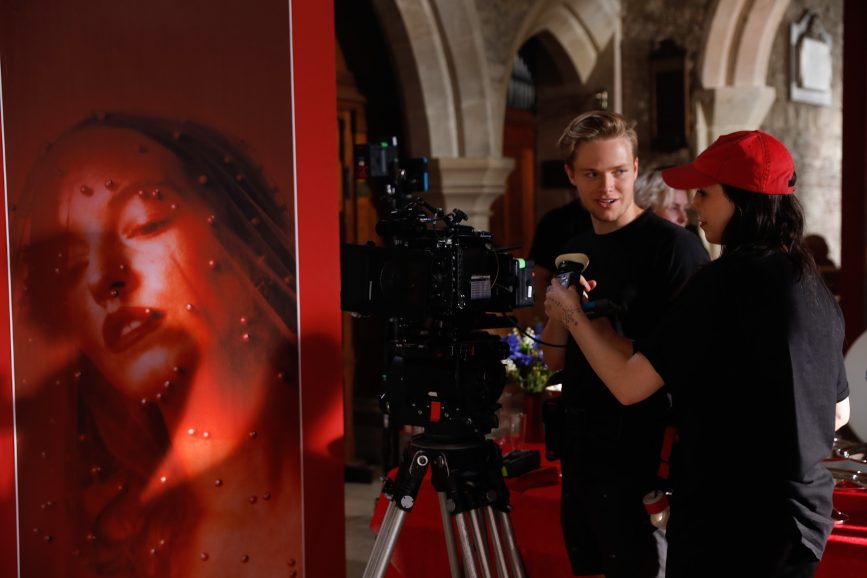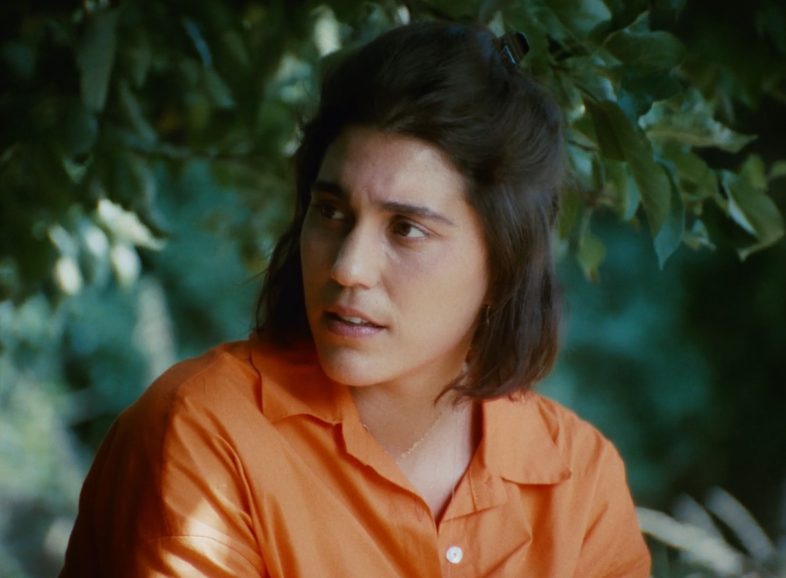An age-defying pill is the focus of Cordelia Lawler’s National Film and Television School (NFTS) graduate film. She shares how she and the team behind the film sought inspiration from ’60s European cinema and leant into a dreamy visual language to highlight the otherworldliness of the story.
A pill that stops the ageing process has just been announced, but only a worthy few are selected to take it in Eterna. Elle, a talented, but shy photographer is not one of those. Stifled by her confident and overachieving friend, Carla, we follow Elle the day after her 30th birthday as she desperately tries to get hold of the pill, by any means possible. A chance meeting with Sonya makes her question her choices.

British Cinematographer: What were your initial discussions about the visual approach for the film? What look and mood were you trying to achieve?
Cordelia Lawler: Our character is an aspiring photographer, and we wanted to use this as theme for the visual language. We planned a lot of long lens shots, as we wanted to create a sense of observation and voyeurism. For this same theme, we also felt that 4:3 would lend itself well, and would also be a contrasting aspect ratio for a neo-sci-fi. Our heroine’s world is her photography – she wears her medium format camera at all times, and so we wanted to emulate an analogue look, but with a drop of the dream-like haziness of a sort-of Alice in Wonderland setting.
BC: What were your creative references and inspirations? Which films, still photography or paintings were you influenced by?
CL: Visually – we were very inspired by Daisies by Věra Chytilová. And Godard’s Le Mépris. We were looking at a lot of photography – colour palette came first, and then it all started to make sense. Initially we were looking at much more classically sci-fi references. However, as the script progressed, one day we were looking at some references with our production designer, Karleigh Engelbrecht, and it just clicked. We were very inspired by ’60s European cinema – the pastel, slightly washed-out colour palette and the texture of film stock.
It’s a story set in slightly surreal version of our world, or in our near future even, but we wanted to lean into a dreamier, softer visual language to aid the otherworldliness of the story.

BC: What filming locations were used? Were any sets constructed? Did any of the locations present any challenges?
CL: We shot almost completely on location, minus the club scene, which was shot behind one of the stages at school. We shot in a church, a warehouse artist’s apartment, and various exterior locations. In all honesty, we had many issues at most of the locations – the schedule was very packed due to the amount of said locations, and so the shoot was a constant state of trying to rethink our approach and overcome the hurdles. It was tricky, but in some ways, it was quite freeing to throw the shot-list out the window everyday. It taught me a LOT about troubleshooting, and about not being precious with previous ideas. It’s important to be adaptable, as not all events can be controlled.
BC: Can you explain your choice of camera and lenses? What made them suitable for this production and the look you were trying to achieve?
CL: We shot on the Alexa Mini, with Super Speeds and Soft FX. I wanted to shoot with some simple but classically beautiful lenses, to aid the analogue, European look we wanted, and I felt that going with a lens choice that was too stylised would take away from this.

BC: What was your approach to lighting the film? Which was the most difficult scene to light?
CL: I found the church/gallery location very challenging, which was not helped by the UK heatwave we were experiencing! The church windows were small and narrow, and most of the action took place in the centre of the church. Not only this, but we were creating a gallery space, and so we had five very large canvas structures in the centre, which were constructed out of wooden flats. Although our designer did an absolutely incredible job of transforming the church, I was fighting with flats, small windows, and small lights as we couldn’t afford a generator for this location
The end scene, where they have a ritual-esque party in the forest, was very exciting for me to light, due to the fact we were in secluded greenery, I was in control of the light (as long as it came within the budget for our generator, which wasn’t small). I love the closeup here of our main character Elle, which was a mix of real fire light and an ARRI Skypanel. When it came to the wide, however, I think I could have been a little braver with my lighting here.
An overall theme for the lighting was to create a glow throughout – a glow on our heroine, and a mirroring glow on the precious pill of eternal youth, which was something I got to have fun with.

BC: What were you trying to achieve in the grade?
CL: We did a lot in the grade, and the director, Villö Krisztics, was heavily involved in this too. Again, we were leaning into this neo-’60s European look, and so we manipulated the colours quite a lot, and ameliorated the celestial glow that is present in many of the scenes. My colourist, Aiden Tobin, did a beautiful with the garden scene in particular – I think the ’60s look comes across here and the colours and the grade sets the stage for the scene.
BC: What were the most challenging parts of the film to shoot and how did you overcome those obstacles?
CL: As I said previously, I think the whole film was probably one of the hardest projects I’ve ever shot, and so really I’d say the whole experience was about overcoming obstacles! I had a lot of fun shooting it though, and I think it’s probably the most I’ve ever learnt on a shoot. I have a great relationship with the director, producer and production designer, and it was a joy to be a part of this project with them.

BC: What was your proudest moment from the production process? Is there a specific scene or shot that you’re especially proud of?
CL: I think my favourite scene visually is the dusk scene in which the heroine walks across a field, through a heavy cloud of morning mist. Personally, I feel it serves as a poignant moment in the start of the film, and I remember the spirits being very high when we were shooting that. I had my lovely friend Devan Clarke-Sheward on Steadicam, with whom I used to work in a kit rental house, and it was nice to see how far we both have come.
BC: What lessons did you learn from this production that you’ll take with you onto future productions?
CL: That I am capable of rising to the challenge in even the most tense of moments; or in a heatwave. And more practically, to be very, very thorough on a location recce.

BC: What would be your dream project as a cinematographer?
CL: I get very excited by projects that are conceptually like moving photographs – my background is in stills, and I love projects that give the actors and the visual language room to breathe. I’m sure it sounds very pretentious, but I know exactly what I mean in my head!










